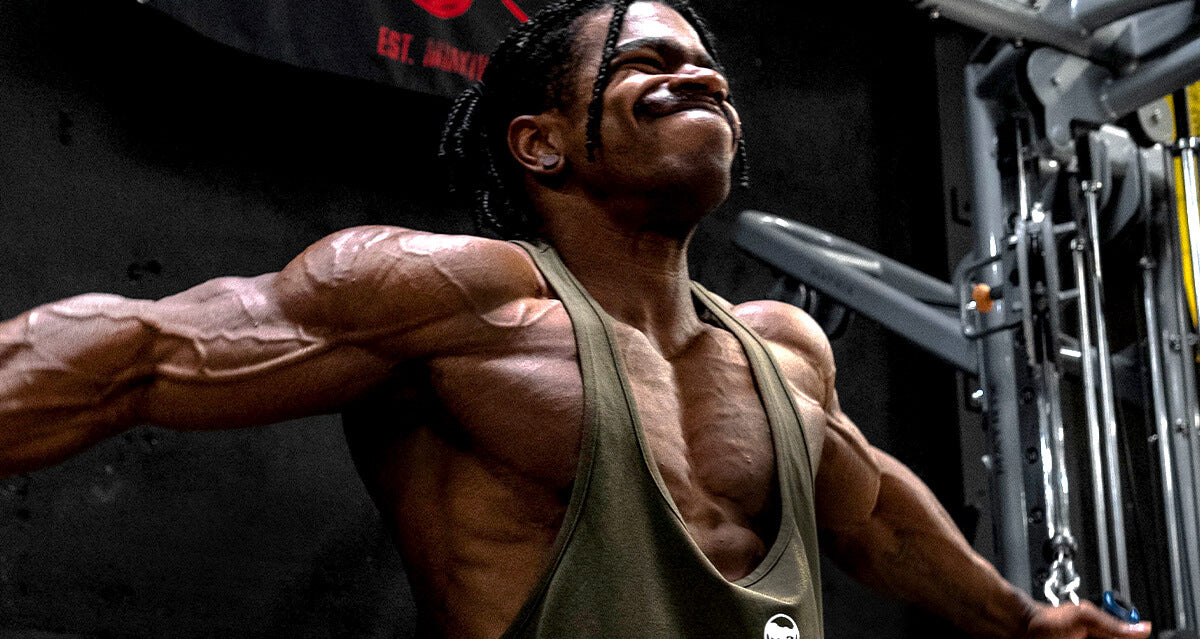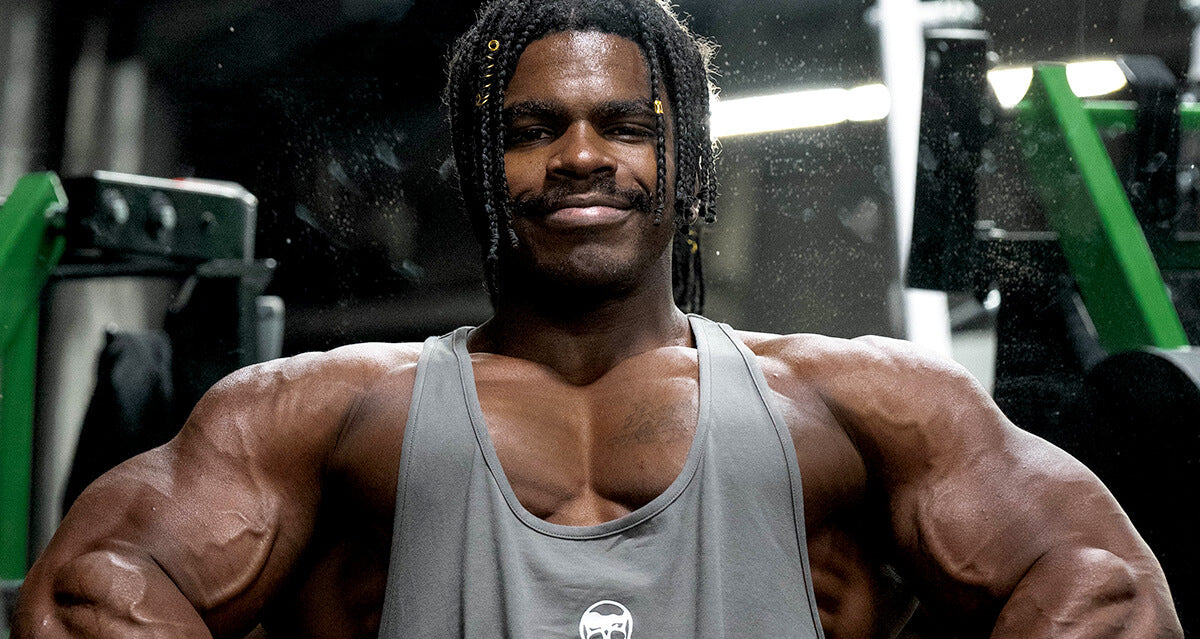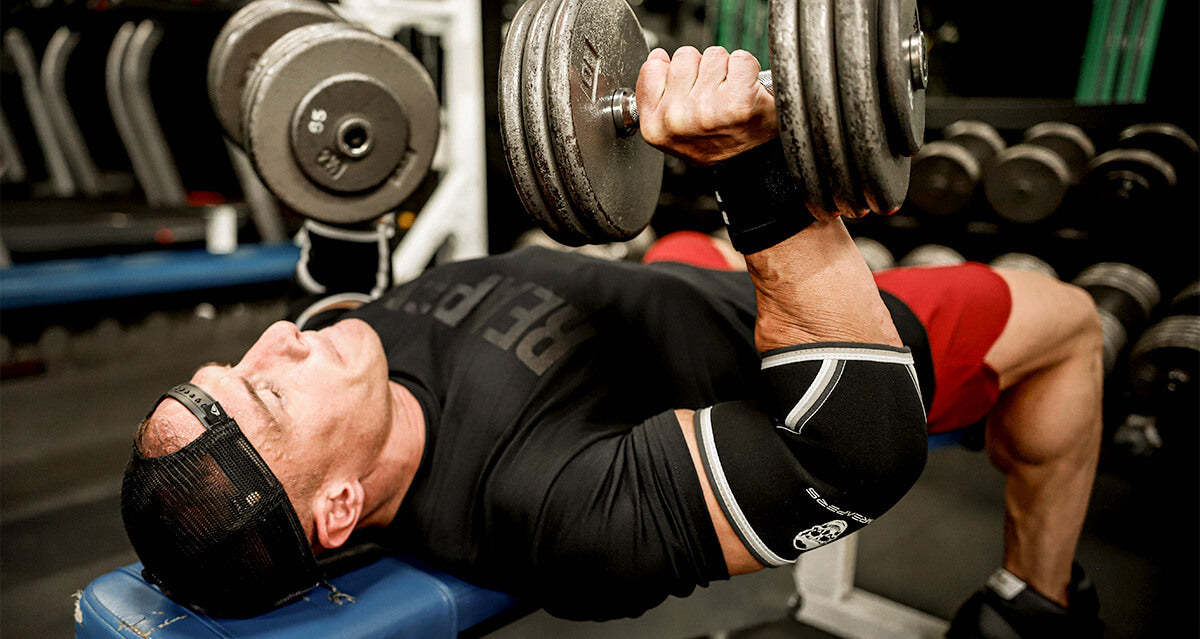Choosing the right cable movements to target the chest is crucial for maximizing muscle growth. If you’re training from home, resistance bands can be a great alternative to cables.
As a strength coach, I know which exercises will help you build a massive chest. I’ll teach you how to perform these exercises, integrate them into your workout routine, and share my favorite cable and resistance band chest workouts. Let's get started.
Key Takeaways
Best Cable Chest Exercises
Here are the ten best cable exercises to maximize chest growth.
1. Upward Chest Fly
The upward fly is a movement that targets the upper muscle fibers of the chest. An isolation exercise by nature, the upward chest fly can help target the pecs without involving the triceps and shoulder.
How To
- Set the pulleys to the lowest setting (knee height or lower), grab the handles with a palms-up grip, and step forward with feet shoulder-width apart, keeping a slight bend in the knees and elbows.
- Lift your arms up and inward using an arcing motion, focusing on using your chest to lift the load while keeping your elbows slightly bent.
- Slowly lower your arms back to the starting position (hands by your sides) while maintaining control and tension in your chest.
Expert Tip: Don't rush the lowering phase. Use a 2-3 second tempo and keep your chest aimed towards the sky and your shoulders back as your arms lower.
2. Downward Chest Fly
The downward chest fly is a movement that targets the chest's middle and lower muscle fibers. It can be performed at varying downward angles.
How To
- Set the pulleys to a level higher than your shoulders, grab the handles with palms up forward, and step forward to create tension in the cables.
- Move your arms forward and downward on an angle, keeping your shoulders back, chest up, and elbows slightly bent.
- Slowly bring your arms back to the starting position, maintaining tension in your chest without letting your shoulders round forward.
Expert Tip: Do not use your shoulders to move the weight down. Keep your chest up and shoulders back the entire time.
3. Middle Chest Fly
The middle chest fly is a movement that targets the middle muscle fibers of the chest, which contribute to the sought-after “chest split”.
How To
- Set the pulleys to a level that is in line with your chest or shoulders (can vary), grab the handles with your palms facing away from you, and step forward so that there is tension in the cables.
- Pull your arms together in front of you while keeping your shoulders back, chest up, and elbows slightly bent and flared out to the sides.
- Slowly bring your arms back to the starting position, maintaining tension in your chest without letting your shoulders rounded forward.
Expert Tip: Focus on sticking your chest out in front of you as you perform both the lifting and lowering phases of the fly, as this will help keep the shoulders out of the movement. Do not let your chest cave in as you bring your hands together.
4. Lying Incline Upward Chest Fly
The lying incline upward chest fly targets the upper chest. This movement requires a bench to help offer more stability for the torso so that you can focus on the fly without worrying about holding your body in certain positions.
This chest exercise is ideal for beginners and lifters who want to train heavier without being limited by core stability.
How To
- Set an incline bench to 15-45 degrees between the cable pulleys with the pulleys in the lowest position possible.
- Lie on your back and grab the pulleys, opening your arms to the sides with slightly bent elbows and palms up towards the ceiling.
- Lift your arms upwards and inwards in an arcing motion, squeezing your chest at the top and lowering slowly back to the starting position.
Expert Tip: Focus on pushing this exercise closer to failure (technical failure, not complete failure), as no other factors (like postural control) limit your ability to exhaust the working muscle.
5. Lying Incline Downward Chest Fly
The lying inclined downward chest fly targets the lower chest. This movement uses the bench to offer stability and helps keep the shoulders from taking over. This variation is an excellent alternative for those who find it difficult not to “cheat” the movement in the standing position.
How To
- Set an incline bench to 15-45 degrees between the cable pulleys. The pulleys should be slightly above shoulder level when you’re on the bench.
- Lay on the bench and grab the pulleys with your palms facing upward.
- Move your arms forward and downwards in an arcing motion, keeping your chest up and shoulders back. Squeeze your lower chest, then slowly return to the start position.
Expert Tip: Drive your head and traps back into the bench as you perform the fly. This cue will help you retract your shoulders and allow your chest to do the work.
6. Cable Crossover
The cable crossover involves crossing your arms over one another at the end of a cable fly for maximum chest contraction. This movement can be performed at varying angles and responds best to moderate to high rep ranges.
How To
- Set the pulleys to the middle or high settings and stand in the center, grabbing the handles with arms extended and palms facing down (high setting) or forwards (middle setting).
- Step forward, bringing your arms together in a wide arc. As you cross one arm over the other, the cables will pass one another.
- Slowly return to the starting position, maintaining control and alternating which hand crosses over the other for each rep.
Expert Tip: Pause briefly in the crossover position and focus on squeezing the chest to maximize muscle contraction.
7. Seated Cable Fly
The seated cable fly is an alternative to the middle chest fly (listed above), as it targets the middle chest. It is often performed with heavier loads than the standing variation because the bench offers more stability.
How To
- Set an adjustable bench to the upright 90-degree position between two pulleys (2-3 feet in front), set at chest height (when seated). Grab the handles with your palms facing one another, ensuring tension on the cables.
- Pull your arms together in front of you while keeping your chest up, shoulders and head back, and elbows slightly bent.
- Slowly lower the weight back to the starting position with control, getting a deep, controlled, loaded stretch on the chest.
Expert Tip: Train this movement with moderate to high reps to failure. The bench will hold your body in position so you can focus more on pushing the chest muscles to their technical limit, stimulating muscle growth.
8. Lying Incline Chest Press
The lying incline chest press trains the upper chest muscle fibers. Unlike the incline fly, this movement responds best to heavier loads and should be used to build strength.
How To
- Set an incline bench slightly to 30-45 degrees in front and between two pulleys.
- Grab the handles with a palm forward position with your elbows bent (as they would be during a bench press), and press upwards and slightly forward on an angle, keeping your chest up and shoulders back.
- Lower your hands slowly as you keep the tension of the chest, and repeat.
Expert Tip: Focus on controlling the lower phase of this movement to increase the tension on the chest muscles. I use a 2-3 second tempo on the lowering phase to increase time under tension and encourage growth.
9. Standing Chest Press
The standing chest press is performed with heavier loads than flies but with less resistance than the seated version, as this variation requires more full-body stability.
How To
- Set the pulleys to chest or shoulder height, and grab the handles with palms down or facing one another position (can vary). Step forward, placing tension on the cables.
- Press the handles forward until your arms are fully extended. Squeeze your chest while maintaining shoulder retraction (keep your shoulders pulled back).
- Slowly bring the handles back to the starting position with control, feeling a deep stretch in the chest.
Expert Tip: If you struggle to maintain stability throughout the press, stagger your stance into a high lunge position to increase your stability.
10. Cable Squeeze Press
The standing cable squeeze press is a chest press variation that adds a squeeze at the end of the press to increase the range of motion and help the lifter achieve a better contraction. This movement can be tricky to do, so it is best used with moderate to lighter loads for higher reps.
How To
- Set the pulleys to chest or shoulder height and stand in the center, holding the handles with elbows bent and palms facing each other. Be sure to step forward enough so the cables have tension.
- Press your arms in front of you and press the handles together in front of your chest, squeezing your chest muscles at the end of the press.
- Slowly return to the starting position, allowing your hands to move apart as they pass the torso, maintaining tension in your chest.
Expert Tip: Do not let the shoulders round forward as you squeeze the hands together. Keep your chest puffed up, and your shoulders pulled back throughout the movement. If you struggle with this, lower the weight.
How Can You Start Training Your Chest With Cables

Here’s your quick start guide to maximize chest muscle growth with cables.
Exercise Selection and Order
Aim for 2-4 total exercises for a cable chest workout.
Choose 1-2 pressing exercises (compound movements) and 1-2 fly exercises (isolation exercises) from varying angles. You can start the workout with either pressing or fly movements.
I find that starting with a fly movement (isolation exercise) and then going into a press (compound exercise) helps achieve a better mind-muscle connection, resulting in a better chest-focused workout.
Sets
Perform 2-4 working sets of each exercise.
After warming up the exercise, your first working set should be challenging. Two to three challenging sets are more effective than four to five somewhat difficult sets that leave too many reps in the tank sets.
Your goal should be effectively stimulating the chest and getting it tired with controlled reps in as few sets as necessary to get the stimulus you need. Once you have done that, move on.
Reps
Aim to train in the 8-10, 10-20, or 20-30 rep range.
I do not recommend training with cables for less than five reps, as the setup and risk of injury are high. Aim to train in the 8-15, 10-20, or 20-30 rep range.
Train your compound pressing movements in the 8-10 and 10-20 rep range, as these movements recruit more muscles and respond best with heavier loads.
Aim for the 10-20 and 20-30 rep ranges for isolation movements like the fly variations, as these muscles are smaller and respond best to light loads pushed to failure.
Wrist stability can be an issue during highly fatiguing, high-rep sets. To prevent wrist stability from limiting your performance, I recommend using Gymreapers 18” wrist wraps. These wraps provide stability but are flexible enough that they don’t limit functionality.
Loading
The load you use is determined by the rep range you are training in; therefore, you want to use a load that is challenging weight within the target rep range.
Since most cable stacks have plenty of weights for most lifters, you should be fine adjusting the weights to fit the rep range you are training in.
Weekly Progressions
The key to muscle growth is progressive overload, so you must progress your training in some capacity every week.
Here’s an example of how you can structure your weekly progressions for cable workouts:
- Week 1: Baseline
- Week 2: Add Reps, Same Weight, and Sets as Week 1
- Week 3: Add Weight, Same Number of Reps and Sets as Week 2
- Week 4: Increase Weight, Reps, or Sets (Whatever You Can)
- Week 5: Increase Weight, Reps, or Sets (Whatever You Can)
- Week 6: Repeat Baseline Weight, Reps, and Sets
Sample Chest Workout With Cables

Beginner
- Lying Incline Upward Chest Fly: 4-5 sets of 8-12 reps, 3-sec lowering phase
- Lying Incline Chest Press: 4-5 sets of 8-12 reps, 3-sec lowering phase
- Seated Flat Chest Press: 4-5 sets of 8-12 reps, 3-sec lowering phase
Intermediate
- Upward Chest Fly: 3 sets of 10-15 reps, with a 2-3 second lowering phase and pause in the bottom
- Seated Flat Chest Press: 4 sets of 8-12 reps, 2-sec lowering phase
- Cable Crossover: 2-3 sets of 20-30 reps, 2-sec lowering phase
Advanced
- Upward Chest Fly: 3 sets of 10-15 reps, with a 2-3 second lowering phase and pause in the bottom
- Seated Flat Chest Press: 4 sets of 8-12 reps, 2-sec lowering phase
- Cable Crossover: 2-3 sets of 15-20 reps, 2-sec lowering phase
- Pair this with Standing Cable Squeeze Press: Use the same weight as the crossover, and do 10-20 slow, controlled reps
If you train from home and want something similar to cables, try resistance bands. Gymreaper resistance bands (be sure to buy two so you can have a pair) and pulley cables can be used for all the same exercises and workouts in this article.
Benefits of Training Your Chest With Cables
The benefits of cable chest workouts are:
Resistance Profile
Cables allow you to keep consistent tension on a muscle throughout the entire range of motion. On the other hand, free weights are subject to gravity's effects and will have varying resistance levels throughout the range of motion.
For example, in a dumbbell chest fly, the resistance is highest in the bottom ranges. As you lift the weight upwards, the resistance is easier to move. With cables, there is constant tension and resistance throughout the entire range of motion.
Guiding You Into Deeper Ranges of Motion
With cables, you can expand the range of motion of pressing and fly movements.
While dumbbells allow you to gain more range of motion than barbells, cables also allow for more range of motion by helping guide you into the deepest positions (due to the cables pulling you down in a more controlled path).
For example, performing flys with cables is helpful as you will know if you are loading the weights at the correct angle because the cable line will pull you into the proper position. Dumbbells can be more challenging for some people to stay aligned properly against gravity.
Ability to Adjust Angles
Training at varying angles is helpful to stimulate muscle growth, as is training around individuals' needs based on their joint angles and body types.
For example, you may notice that adjusting the angle of a chest fly by 1-2” takes the pressure off the shoulders and places more tension on the upper chest. While you can make angular adjustments with benches and free weights, you have even more control over the angles with cables.
No Spotter Needed
There is no need for a spotter when training with cables, mainly because failing a rep just means returning the weights to the stack.
Additionally, you are working with lower loads and training in a more concentrated and controlled manner, generally decreasing the risk of injury.
Frequently Asked Questions
How Often Should I Do Cable Chest Workouts?
Cable exercises can be great for building muscle. However, I don't recommend using cables for all your chest workouts (unless you ONLY have cables). The chest can be trained 2-3 times a week, so you could do a cable exercise chest workout if desired.
Can Cable Exercises Replace Free Weight Exercises?
No, cables are not a replacement for free weights, as they offer constant resistance throughout the range of motion. If you can access both cables and free weights, I recommend using both in your workouts.
How Long Before I See Results?
Like all resistance training, it will take 6-8 weeks of consistent chest workouts (2-3 times a week) to see results. You will first notice improvements in gym performance after a few sessions, and if you eat to support your workouts and muscle growth, you should see visible changes in as little as 6-8 weeks.















Leave a comment
All comments are moderated before being published.
This site is protected by hCaptcha and the hCaptcha Privacy Policy and Terms of Service apply.